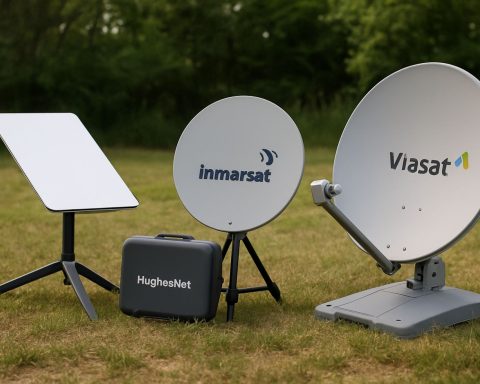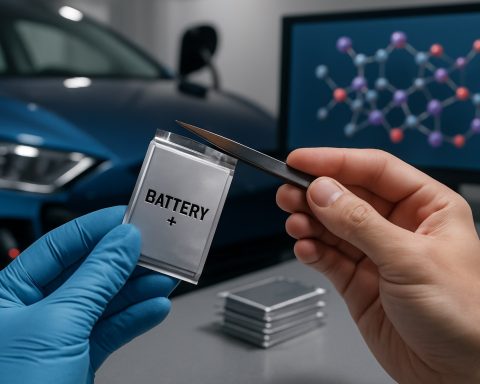- Lansing, Michigan, hosts a new LG Energy Solution-owned battery manufacturing facility, promising to transform energy storage in the U.S.
- The plant was initially a joint venture with General Motors but is now fully owned by LGES, involving over $2 billion in investment.
- Almost 98% complete, the facility has provided significant employment during construction and will create at least 1,360 permanent, high-paying jobs.
- The factory will produce high-voltage batteries for various applications, including electric vehicles and energy storage systems.
- Situated in the heart of the American auto industry, the facility underscores Michigan’s central role in future automotive and energy technology.
- The Ultium plant symbolizes a commitment to innovation, economic growth, and environmental stewardship, setting a path towards a sustainable future.
Amidst the noise of the bustling auto sector, a silent revolution is happening in Lansing, Michigan. A concrete behemoth now stands almost complete, cloaked with the promise of innovation—a battery manufacturing facility that could redefine the future of energy storage in the United States. This project, which began as a joint venture between automotive giant General Motors and the cutting-edge innovators at LG Energy Solution (LGES), has recently undergone a significant transformation.
Gone are the hesitations of shared ownership; LGES has boldly taken the helm as the sole proprietor of the Ultium plant. With this strategic maneuver, LGES isn’t just claiming a building—it’s claiming the future of automotive technology. A hefty investment exceeding $2 billion underscores their commitment, a financial vote of confidence in Michigan’s workforce and industrial acumen.
Inside the nearly finished facility, a symphony of hammers, drills, and cranes performs its well-rehearsed opus. Ninety-eight percent of the construction work is complete, a testament to the tireless builders whose hands and sweat have shaped this site over the past 18 months. This ambitious project wasn’t just a construction challenge; it has been a boon for thousands, employing countless skilled workers from across the state.
As dust gives way to digital displays and assembly lines, LG Energy Solution promises stability and growth. The company has assured the creation of at least 1,360 permanent, high-paying jobs, anchoring local economic growth while preparing to throttle the acceleration of battery production across the continent.
Those with a finger on the pulse of technology recognize the strategic brilliance of LGES’s investment. The facility will churn out high-voltage batteries designed not just for automobiles but also for a range of applications that promise to redefine how we store and consume energy. From electric vehicles poised to glide silently on city streets, to robust energy storage systems that will stabilize the grids of tomorrow, the scope is both vast and vital.
Synthesizing this immense potential is the location itself. Situated in Lansing, within the nucleus of the American auto industry, the facility stands as a potent affirmation of Michigan’s central role in future automotive and energy technology landscapes. The area’s storied history with cars now melds with the promise of next-generation energy solutions, setting the stage for economic and technological renaissance.
In crafting a sustainable future, the Ultium plant is more than just bricks and metal. It is a pledge—a galvanic surge toward innovation, employment, and environmental stewardship. And as LGES charts its course through the competitive waters of global technology, the Lansing facility emerges as a lighthouse guiding Michigan, and by extension the nation, toward a battery-powered tomorrow. The people of Michigan and beyond now look to a future charged with possibility, led by ambition and powered by lithium dreams.
The Future of Energy: How LG Energy Solution’s Ultium Plant is Revolutionizing Battery Manufacturing
Overview of LG Energy Solution’s Ultium Plant Transformation
The Ultium plant in Lansing, Michigan, previously a collaborative effort between General Motors and LG Energy Solution (LGES), is now a symbol of an evolving energy landscape, with LGES stepping up as the sole proprietor. This shift highlights LGES’s strategic focus on becoming a leader in innovative battery technologies, particularly for electric vehicles (EVs) and energy storage systems. This transition is marked by a significant financial commitment exceeding $2 billion, highlighting LGES’s trust in local expertise and its vision for a sustainable future.
Key Highlights and Features of the Ultium Battery Plant
– Job Creation and Economic Impact: The plant is expected to create at least 1,360 permanent jobs, injecting vitality into the local economy and establishing Lansing as a hub for battery technology. These positions are anticipated to be high-paying, bringing substantial economic benefits to the community.
– Technological Scope and Production Capacity: Set to produce high-voltage batteries, the facility aims not only to serve the automotive industry but also to diversify applications across various energy sectors. This includes stabilizing energy grids and powering a range of technological solutions, showcasing the versatility of modern battery storage.
– Strategic Location: Located in Lansing, the plant benefits from its strategic proximity to the American auto industry heartland, reinforcing Michigan’s pivotal role in the next wave of technological advancements in both automotive and energy domains.
Industry Trends and Forecasts
1. Electric Vehicle Market Growth: The EV market is projected to grow significantly, with expectations of EVs making up over 50% of global car sales by 2030 (source: International Energy Agency). This trend underscores the demand for advanced battery technologies like those from the Ultium plant.
2. Energy Storage Systems: As renewable energy sources like wind and solar become more prevalent, the need for robust energy storage solutions is pressing. The Ultium plant’s focus on energy storage aligns with this global trend towards sustainability and reduced carbon footprints.
3. Battery Technology Evolutions: With advancements in battery chemistries, such as solid-state batteries, the Ultium plant is poised to adapt and innovate, ensuring competitiveness and leadership in the field.
Pressing Questions and Expert Insights
– Why is LGES Investing in Lansing Specifically? Lansing’s history and expertise in automotive manufacturing provide a skilled workforce and a strategic advantage for battery production, facilitating seamless integration with automotive clients.
– How Will the Facility Impact Sustainability Goals? By producing batteries that support EVs and renewable energy solutions, LGES contributes to reducing carbon emissions and fostering a sustainable energy future.
– Are There Any Limitations or Concerns? The primary challenges lie in ensuring a steady supply chain for raw materials, such as lithium, which are critical for battery production. Efforts to enhance recycling and develop alternative materials are ongoing to address these issues.
Actionable Recommendations
1. For Job Seekers: Those interested in technology and manufacturing should explore opportunities at the Ultium plant, as it promises not only stable employment but also advancements in cutting-edge technology.
2. For Investors: Investing in renewable energy and electric vehicle technologies can be lucrative as market demand grows, with facilities like Ultium leading the charge.
3. For Policymakers: Supporting facilities that advance sustainable technologies and create jobs can contribute to broader economic growth and environmental goals.
For further information on the developments in battery technology and renewable energy solutions, visit LG Energy Solution. Stay informed about the energy future and explore opportunities in this evolving sector.
By championing innovation and fostering local growth, LG Energy Solution’s Ultium plant stands as a beacon of what’s possible in a world moving towards sustainable energy solutions.










